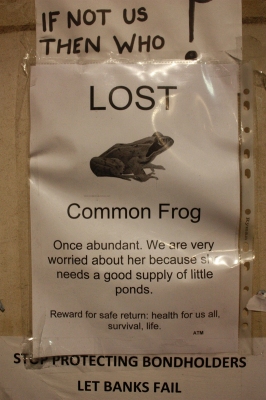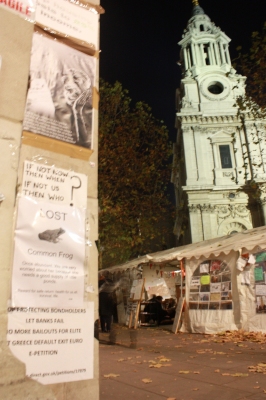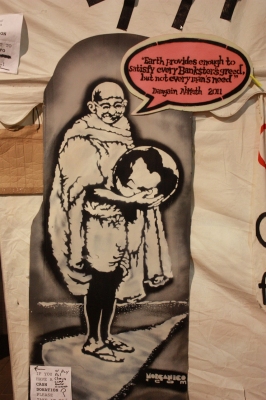


If you wander along the artwork, banners, art installations and the many messages plastered over pillars and the nearby buildings at the Occupy London Protest site (otherwise known as #OccupyLSX) you may notice makeshift posters highlighting the plight of UK wildlife. Probably a strange place for such messages to appear. It was refreshing to see amongst the socialist, anarchist proverbs and other statements against corporations, banks and society.
The posters are printed on paper and placed into plastic folders taped onto the walls of buildings and pinned to the street trees around St Paul's Cathedral. The animals featured include the small tortoiseshell butterfly and honey bee. As I walked back towards the underground I spotted an amphibian poster - the common frog.
The Campaign Against Urban Sprawl has adopted Nathan the Natterjack a species which is endangered in the UK and is apparently threatened by the government's plans for the National Planning System. The common frog is also threatened as it is widespread, it is declining and the animal and its habitat is not protected at all.
The common frog is the best known amphibian in the UK so perhaps a stroke of genius, on the part of the unnamed posterer, it brings attention to the lost of wildlife habitats in the UK. The common frog has suffered due to 70+ years of intensive agriculture which removed its breeding habitat from the heart of the countryside.
The solution as the poster says the frog needs 'a good supply of little ponds' and so does British freshwater biodiversity. This tenuous link takes us to the Million Ponds Project by Pond Conservation. The project's aim is to bring back 600,000 ponds over 50 years. In the first few years of the project hundreds of ponds have been created with the help of various partners including local ARG's charities, nature organisations, land owners etc.
The ARG UK are developing a project for 2012 to dig a further 1,000 ponds over the UK using volunteers following the criteria set out in the Million Ponds Project Pond toolkit -
- Clean water (rain fed)
- at least 1m2 in diameter
- filled for 4 months of the year
- left to colonise naturally